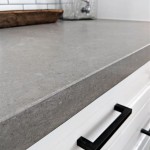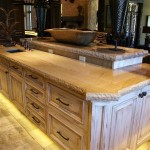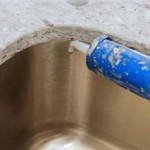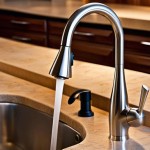Formica Countertop Cleaner and Polish: Maintaining Surface Integrity and Aesthetics
Formica countertops are a popular choice for residential and commercial spaces due to their durability, affordability, and wide range of aesthetic options. However, like any surface, Formica requires regular cleaning and occasional polishing to maintain its appearance and extend its lifespan. This article will detail the proper methods and appropriate products for cleaning, polishing, and generally caring for Formica countertops.
The longevity and visual appeal of Formica surfaces are directly related to the level of care they receive. Neglecting proper cleaning can lead to the buildup of grime, stains, and even microscopic scratches that dull the surface. Using harsh or abrasive cleaners can cause irreversible damage, compromising the integrity of the protective layer. Therefore, understanding the nuances of Formica care is crucial for homeowners and business owners alike.
Understanding Formica Composition and Vulnerabilities
Formica, technically known as High-Pressure Laminate (HPL), is a composite material constructed from multiple layers of paper saturated with resin. These layers are then compressed under high pressure and heat, resulting in a durable, non-porous surface. The top layer, often a decorative sheet, is typically coated with a melamine resin, which provides resistance to scratches, heat, and moisture. However, this resistance is not absolute, and Formica is still susceptible to damage from certain substances and improper cleaning techniques.
Acidic substances, such as lemon juice, vinegar, and certain cleaning solutions, can etch the surface of Formica, leaving a dull or discolored mark. Abrasive cleaners and scrubbing pads can scratch the melamine layer, reducing its sheen and making it more susceptible to staining. Excessive heat from hot pans or appliances can also cause blistering or warping of the Formica surface. Furthermore, while Formica is water-resistant, prolonged exposure to standing water can seep into the seams and edges, causing the core material to swell and delaminate.
Understanding these vulnerabilities is the first step in developing a proper maintenance strategy. By avoiding harsh chemicals, abrasive materials, and excessive heat and moisture, one can significantly extend the life and maintain the beauty of Formica countertops.
Routine Cleaning Procedures for Formica Countertops
Regular cleaning is essential for preventing the buildup of dirt, grime, and stains on Formica surfaces. The frequency of cleaning will depend on the level of use and the types of activities performed on the countertop. In general, daily or after-meal cleaning is recommended to remove spills and prevent stains from setting.
For routine cleaning, a mild dish soap solution is typically sufficient. Mix a small amount of dish soap with warm water in a bucket or spray bottle. Using a soft cloth or sponge, gently wipe down the entire countertop surface, paying particular attention to areas with visible dirt or spills. Avoid using abrasive scrubbing pads, as they can scratch the surface.
After wiping down the countertop with the soapy solution, rinse the surface thoroughly with clean water. This is important to remove any soap residue, which can attract dirt and leave a dull film. Use a separate clean cloth or sponge to wipe away the water, and then dry the countertop with a clean, dry cloth. Proper drying is crucial to prevent water spots and potential water damage to the edges and seams.
For stubborn stains, such as grease or food residue, a slightly stronger cleaning solution may be necessary. A paste made from baking soda and water can be gently applied to the stain and left to sit for a few minutes before being wiped away. However, it is crucial to test this paste in an inconspicuous area first to ensure it does not damage the Formica finish. Alternatively, a commercially available Formica cleaner specifically designed for laminate surfaces can be used, following the manufacturer's instructions carefully.
Avoid using harsh chemicals, such as bleach, ammonia, or concentrated detergents, as they can discolor or damage the Formica surface. Also, avoid using abrasive cleaners or scouring pads, as they can scratch the protective melamine layer. Remember that prevention is key, so promptly wiping up spills and avoiding potentially damaging substances is always the best approach.
Polishing Formica Countertops: Restoring Shine and Protecting the Surface
While regular cleaning helps maintain the cleanliness of Formica countertops, polishing can restore their shine and provide an extra layer of protection. Polishing is not a daily requirement but should be performed periodically, depending on the level of wear and tear the countertop experiences.
Before polishing, ensure the countertop is thoroughly cleaned and dry. Any dirt or grime left on the surface will only be spread around during the polishing process, potentially causing scratches. Choose a polish specifically designed for laminate surfaces. These polishes typically contain mild abrasives that help buff away minor scratches and restore the surface's luster. Avoid using polishes intended for wood or stone, as they may contain ingredients that can damage Formica.
Apply a small amount of polish to a clean, soft cloth. Using a circular motion, gently rub the polish onto the countertop surface, working in small sections at a time. Apply consistent pressure, but avoid pressing too hard, as this can cause uneven polishing. Allow the polish to sit on the surface for the amount of time recommended by the manufacturer, typically a few minutes.
After the recommended waiting period, use a clean, dry cloth to buff the countertop surface. Continue buffing until the polish is completely removed and the surface is smooth and shiny. Pay particular attention to areas that appear dull or scratched, and continue buffing until the desired level of shine is achieved.
An alternative to commercial polishes is using a mixture of mineral oil and lemon juice. Apply a small amount of the mixture to a soft cloth and rub it onto the countertop surface in a circular motion. Let it sit for a few minutes, then buff with a clean, dry cloth. This DIY polish can help restore shine and protect the surface, but it's essential to test it in an inconspicuous area first to ensure it doesn't damage the Formica.
Frequency of polishing depends on the countertop’s usage and exposure to wear. High-traffic areas might benefit from polishing every few months, while less frequently used countertops may only require polishing once or twice a year. Proper polishing will not only enhance the aesthetic appeal of the Formica but also contribute to its longevity by providing a protective barrier against scratches and stains.
Key Considerations for Specific Types of Formica and Finishes
While the general cleaning and polishing procedures outlined above are applicable to most Formica countertops, certain types and finishes may require specific considerations. For example, textured Formica surfaces, such as those with a matte or embossed finish, can be more challenging to clean than smooth surfaces. The texture can trap dirt and grime, making it more difficult to remove. In these cases, a soft-bristled brush or a sponge with a textured surface may be necessary to reach into the crevices and remove the dirt.
Dark-colored Formica countertops tend to show scratches and water spots more readily than light-colored surfaces. Therefore, special care should be taken to avoid scratching these surfaces and to ensure they are thoroughly dried after cleaning. Using a microfiber cloth can help minimize streaks and water spots on dark Formica.
Formica countertops with a high-gloss finish are particularly susceptible to scratching. Avoid using abrasive cleaners or scrubbing pads on these surfaces, and be extra careful when polishing to avoid creating swirl marks. Applying a thin coat of wax after polishing can help protect the finish and enhance its shine.
When cleaning and polishing Formica countertops around sinks and faucets, pay particular attention to the seams and edges. These areas are prone to water damage, which can cause the core material to swell and delaminate. Ensure these areas are thoroughly dried after each cleaning and consider sealing them with a silicone caulk to prevent water from penetrating.
For high-end or custom Formica countertops, consulting with the manufacturer or a professional cleaning service may be advisable. They can provide specific recommendations for cleaning and maintaining the particular type of Formica and finish used in the countertop. Following these recommendations will help ensure the countertop remains in optimal condition for years to come.
How To Polish Formica Howstuffworks

Hope S Perfect Countertop Cleaner And Polish Streak Free Multi Surface Cleaning Spray 22 Fl Oz Pack Of 1

Countertop Magic 13oz Spray
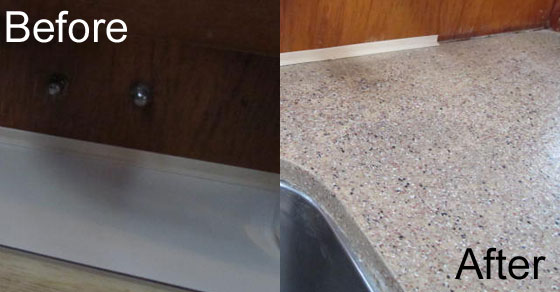
Restoring Formica On A Boat The Galley

Hope S 22 Fl Oz Fresh And Clean Liquid Cleaner Polish 22ct6 At Com

Re A Bleached Or Faded Laminate Countertop Rejuvenate

Laminate Countertops Update

Hope S 22 Fl Oz Fresh And Clean Liquid Cleaner Polish 22ct6 At Com
Re Plastic Laminate Countertops In Easy Steps

Laminate Countertop Cleaners The Home
See Also


